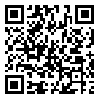Sat, Nov 22, 2025
Volume 35, Issue 3 (6-2025)
JHNM 2025, 35(3): 168-178 |
Back to browse issues page
Download citation:
BibTeX | RIS | EndNote | Medlars | ProCite | Reference Manager | RefWorks
Send citation to:



BibTeX | RIS | EndNote | Medlars | ProCite | Reference Manager | RefWorks
Send citation to:
Kabir K, Tourkashvand S, Mehdizadeh Tourzani Z, Yazdkhasti M. Effectiveness of Onosma dichroanthum Boiss Combined Ointment on Episiotomy Healing and Pain in Primiparous Women: A Randomized, Clinical Trial. JHNM 2025; 35 (3) :168-178
URL: http://hnmj.gums.ac.ir/article-1-2336-en.html
URL: http://hnmj.gums.ac.ir/article-1-2336-en.html
1- Associate Professor of Community and Family Medicine, Department of Community and Family Medicine, School of Medicine, Firoozabadi Clinical Research Development Unit, Iran University of Medical Sciences, Tehran, Iran.
2- Instructor, School of Medicine, Alborz University of Medical Sciences, Karaj, Iran.
3- Instructor, Department of Midwifery and Reproductive Health, School of Medicine, Alborz University of Medical Sciences, Karaj, Iran.
4- Associate Professor, Department of Midwifery and Reproductive Health, Social Determinants of Health Research Center, School of Medicine, Alborz University of Medical Sciences, Karaj, Iran. ,Mansoyazd@yahoo.com
2- Instructor, School of Medicine, Alborz University of Medical Sciences, Karaj, Iran.
3- Instructor, Department of Midwifery and Reproductive Health, School of Medicine, Alborz University of Medical Sciences, Karaj, Iran.
4- Associate Professor, Department of Midwifery and Reproductive Health, Social Determinants of Health Research Center, School of Medicine, Alborz University of Medical Sciences, Karaj, Iran. ,
Abstract: (411 Views)
Introduction: Incomplete wound healing or episiotomy pain can cause short-term or long-term physical, psychological, and sexual complications for women.
Objective: This study aimed to assess the efficacy of Onosma dichroanthum Boiss combined (ODBC) ointment on episiotomy healing and pain relief in primiparous women.
Materials and Methods: A double-blind, randomized clinical trial was conducted on 190 primiparous women in a therapeutic education center in Karaj City, Iran, from December 2022 to March 2023. Eligible women were randomly assigned to either the intervention or control group using the block randomization method (95 participants in each group). The intervention group applied 2 g of ODBC ointment every 8 hours, starting 4 hours and continuing until 10 days post-delivery. Equally, the control group received a placebo following the same schedule. Study data were collected at 4 time points using the Redness, Edema, Ecchymosis, Discharge, Approximation (REEDA) and Visual Analog Scale (VAS) tools. The data were analyzed using the chi-squared, independent t, Mann-Whitney, and Friedman tests.
Results: Before the intervention, both groups exhibited homogeneity in demographic and gestational characteristics such as age, Body Mass Index (BMI), Job, level of education, gestational age, number of pregnancies, and birth weight. The Mean±SD age and BMI in the intervention and control groups were 27±5.7 and 27.28±4.69 years, as well as 23.59±4.68 and 24.02±4.83 kg/m2, respectively. Four hours after the intervention, a statistically significant difference between the two groups was observed in pain (P=0.01, 6.09±2.02 to 4.77±1.85) and healing scores (P=0.01, 2.75±0.43 to 2.41±0.49). A significant difference in changes in pain score and healing was observed in the intervention group at 4 time points: before the intervention, 4 hours, 5 days, and 10 days after the intervention (P=0.001). In contrast, no statistically significant change was seen in the control group.
Conclusion: Based on the results, it succinctly communicates the positive impact of ODBC ointment on the healing process of the episiotomy wound and the reduction of pain intensity in that area, which can be noticed in episiotomy wound care.
Objective: This study aimed to assess the efficacy of Onosma dichroanthum Boiss combined (ODBC) ointment on episiotomy healing and pain relief in primiparous women.
Materials and Methods: A double-blind, randomized clinical trial was conducted on 190 primiparous women in a therapeutic education center in Karaj City, Iran, from December 2022 to March 2023. Eligible women were randomly assigned to either the intervention or control group using the block randomization method (95 participants in each group). The intervention group applied 2 g of ODBC ointment every 8 hours, starting 4 hours and continuing until 10 days post-delivery. Equally, the control group received a placebo following the same schedule. Study data were collected at 4 time points using the Redness, Edema, Ecchymosis, Discharge, Approximation (REEDA) and Visual Analog Scale (VAS) tools. The data were analyzed using the chi-squared, independent t, Mann-Whitney, and Friedman tests.
Results: Before the intervention, both groups exhibited homogeneity in demographic and gestational characteristics such as age, Body Mass Index (BMI), Job, level of education, gestational age, number of pregnancies, and birth weight. The Mean±SD age and BMI in the intervention and control groups were 27±5.7 and 27.28±4.69 years, as well as 23.59±4.68 and 24.02±4.83 kg/m2, respectively. Four hours after the intervention, a statistically significant difference between the two groups was observed in pain (P=0.01, 6.09±2.02 to 4.77±1.85) and healing scores (P=0.01, 2.75±0.43 to 2.41±0.49). A significant difference in changes in pain score and healing was observed in the intervention group at 4 time points: before the intervention, 4 hours, 5 days, and 10 days after the intervention (P=0.001). In contrast, no statistically significant change was seen in the control group.
Conclusion: Based on the results, it succinctly communicates the positive impact of ODBC ointment on the healing process of the episiotomy wound and the reduction of pain intensity in that area, which can be noticed in episiotomy wound care.
Article Type : Research |
Subject:
Special
Received: 2024/04/13 | Accepted: 2025/02/23 | Published: 2025/06/10
Received: 2024/04/13 | Accepted: 2025/02/23 | Published: 2025/06/10
Send email to the article author
| Rights and permissions | |
 | This work is licensed under a Creative Commons Attribution-NonCommercial 4.0 International License. |






